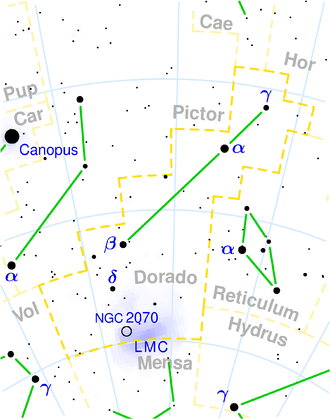NGC 1553
| Galaxy NGC 1553 |
|
|---|---|

|
|
| Photo from the Hubble Space Telescope | |
| AladinLite | |
| Constellation | Swordfish |
|
Position equinox : J2000.0 , epoch : J2000.0 |
|
| Right ascension | 04 h 16 m 10.47 s |
| declination | -55 ° 46 ′ 48.5 ″ |
| Appearance | |
| Morphological type | SA (rl) 0 ^ 0 / LINER |
| Brightness (visual) | 9.0 mag |
| Brightness (B-band) | 10.0 mag |
| Angular expansion | 4.5 ′ × 2.8 ′ |
| Position angle | 150 ° |
| Surface brightness | 11.6 mag / arcmin² |
| Physical data | |
| Affiliation |
Dorado group SSRS group 13 NGC 1566 group LGG 112 |
| Redshift | 0.003602 ± 0.000037 |
| Radial velocity | 1080 ± 11 km / s |
|
Stroke distance v rad / H 0 |
(40 ± 3) x 10 6 ly (12.4 ± 0.9) Mpc |
| diameter | 100,000 ly |
| history | |
| discovery | John Herschel |
| Discovery date | December 5, 1834 |
| Catalog names | |
| NGC 1553 • PGC 14765 • ESO 157-017 • IRAS 04150-5554 • 2MASX J04161046-5546485 • SGC 041505-5554.2 • GC 8381 • h 2630 • GALEX ASC J041610.48-554648.0 • LDCE 328 NED007 • WISEA J04464810.43 | |
NGC 1553 is a lens-shaped galaxy with an active nucleus of the Hubble type S0 in the constellation Swordfish in the southern sky . It is estimated to be 40 million light-years away from the Milky Way and about 60,000 light-years across. Together with the approx. 175,000 light years. from NGC 1549 distant from it , it forms an interacting galaxy pair and is the brightest member of the NGC 1553 group ( LGG 112 ).
The galaxies NGC 1546 , IC 2058 , IC 2060 are located in the same area of the sky .
The object was discovered on December 5, 1834 by the British astronomer John Herschel .
NGC 1553 group ( LGG 112 )
| Galaxy | Alternative name | Distance / million ly |
|---|---|---|
| NGC 1543 | PGC 14659 | 45 |
| NGC 1546 | PGC 14723 | 50 |
| NGC 1549 | PGC 14757 | 48 |
| NGC 1553 | PGC 14765 | 40 |
| NGC 1574 | PGC 14965 | 39 |
Web links
Commons : NGC 1553 - collection of images, videos, and audio files
